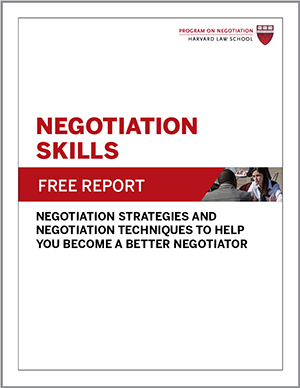
How can managers and their organizations increase the odds that negotiation training will lead to beneficial long-term results? Here are several pieces of advice, drawn from experts at the Program on Negotiation at Harvard Law School.
1. Get Your Team On the Same Page About Negotiation Training
The only way that an organization and its employees will know how to negotiate is by training them. Organizations across the globe spend many millions of dollars each year on negotiation training for their employees. This training can be in-house, led by consultants and other experts, or employees can travel to training programs at universities and elsewhere. After engaging in a couple of days of training, employees return to the office and attempt to apply what they learned. Unfortunately, their new knowledge often fails to “stick.” They quickly abandon the best practices they learned during negotiation training and replace them with ineffective old habits. Read Implement Negotiation Training in Your Organization to learn five ways to make negotiation training “stick” in your organization.
2. Teach the Mistakes of Past Negotiations
Business professionals seeking to improve their negotiation training can learn a great deal from the mistakes made in newsworthy negotiations. One example that can be used in negotiation training comes from Steven M. Davidoff of the New York Times’ “DealBook.” He analyzed how the U.S. government rushed negotiations to save U.S. automaker Chrysler back in 2009 and how that led to a costly long-term problem. Read For Better Negotiation Training, Study the U.S. Government’s Mistakes to learn more. You can also read Real Life Examples of Bargaining Gone Wrong.
3. Teach Hard-Bargaining Skills
Negotiating skills for dealing with situations as they arise at the bargaining table are always in high demand. Strategies prepared before coming to the bargaining table are one way to anticipate events during negotiations, but expert negotiators know that the bargaining style of their counterpart will impact, positively or negatively, even the best-laid plans. Don’t let anyone in your organization be caught unprepared by hard bargainers. Read 10 Hard Bargaining Negotiation Skills.
4. Teach How Conflicts of Interest Can Affect a Negotiation
Negotiators and other decision-makers sometimes have the difficult task of remaining impartial when facing a conflict of interest. The actions of the special committee of Dell’s board as the company’s CEO and founder, Michael Dell, moved forward with a leveraged buyout suggest precautions you can take when navigating such delicate situations. Read Coping with Conflicts of Interest.
5. Teach How to Leverage Your Emotions
In typical negotiation training, we are taught to get beyond our emotions and look at situations rationally. There’s merit to this approach, of course, as feelings can cloud our judgment. But consider what Lieutenant Jack Cambria, who retired in August as the longest-running head of the New York Police Department’s (NYPD’s) hostage negotiation team, said during an interview with the Wall Street Journal: Successful negotiators must “experience the emotion of love at one point in their life, to know what it means to have been hurt in love at one point in their life, to know success and, perhaps most important, to know what it means to know failure.” He concluded, “The very good negotiators, I think, are the ones with the life stories.” Read Negotiation Training with Heart to read the rest of the story.
6. Also Teach How to Control Your Emotions
To guard against acting irrationally or in ways that can harm you, authors of Beyond Reason: Using Emotions As You Negotiate Roger Fisher and Daniel Shapiro advise you to take your emotional temperature during a negotiation. Specifically, try to gauge whether your emotions are manageable, starting to heat up, or threatening to boil over. Read How to Control Your Emotions in Conflict Resolution and learn three ways to lower your emotional temperature.
7. Teach How to Build Relationships
At the negotiation table, what’s the best way to uncover your negotiation counterpart’s hidden interests? Build a relationship in negotiation by asking questions, then listening carefully. Even if you’ve decided to make the first offer and are ready with a number of alternatives, always open by asking and listening to assess interests. Note that if your style of listening isn’t sufficiently empathetic, it won’t elicit honest responses. A relationship in negotiation is a perceived connection that can be psychological, economic, political, or personal; whatever its basis, wise leaders, like skilled negotiators, work to foster a strong connection because effective leadership depends on it. Read The Importance of Relationships in Negotiation to learn how to build trust within a negotiation.
8. Try Role Playing as a Part of Negotiation Training
Role-playing puts participants in hypothetical situations and challenges them to deliberate and make decisions in new and different ways. Role-play simulations foster both individual and collective learning that can be transferred to “real world” situations. They also provide safe and flexible settings for experimentation. Read more in Learning From Negotiation Role-Plays. You can find more than 200 role-play simulations available through the Program on Negotiation’s Teaching Negotiation Resource Center. Also, read about the four obstacles of learning from simulations.
9. Test Scorable Negotiating Exercises
Simulations allow students to embrace unfamiliar situations (and thus build up their improvisational capabilities). Current research shows that learners grasp and retain concepts better in experiential learning environments, like simulations, in contrast to theoretical teaching methods, like lectures. And while scorable simulations have a range of strengths and weaknesses, simulations – whether scorable or not – can contribute to negotiation instruction in a number of ways. Read The Value of Using Scorable Simulations in Negotiation Training.
10. Evaluate a Student’s Performance With Scores and Without
Whether to grade student role-play performance, process and outcomes is a tricky question. Jim Lawrence, a long-time PON contributor, simulation author, attorney and practicing mediator with Frost Brown Todd LLC, shared his thoughts on the value and purpose of grading students participating in negotiation simulations in Grading a Negotiation: Examples of How to Evaluate Student Performance.
In addition to all of these negotiation training tips, we recommend catching up with the best negotiation training books. Whether you are facing negotiations with Congress, colleagues, customers, or family members, the negotiation books in this list, published in recent years by experts from the Program on Negotiation, offer new perspectives on common negotiating dilemmas. Additionally, we suggest joining us at Negotiation and Leadership: Dealing With Difficult People and Problems, the ultimate negotiation training event. Negotiation and Leadership distills cutting-edge research and real-world examples into three days of targeted executive education negotiation training.
What negotiation training challenges have you faced in your organization? Share them in the comments below.





